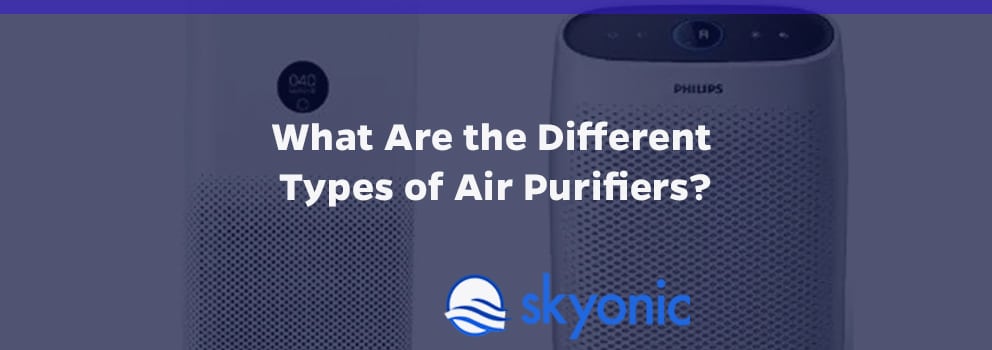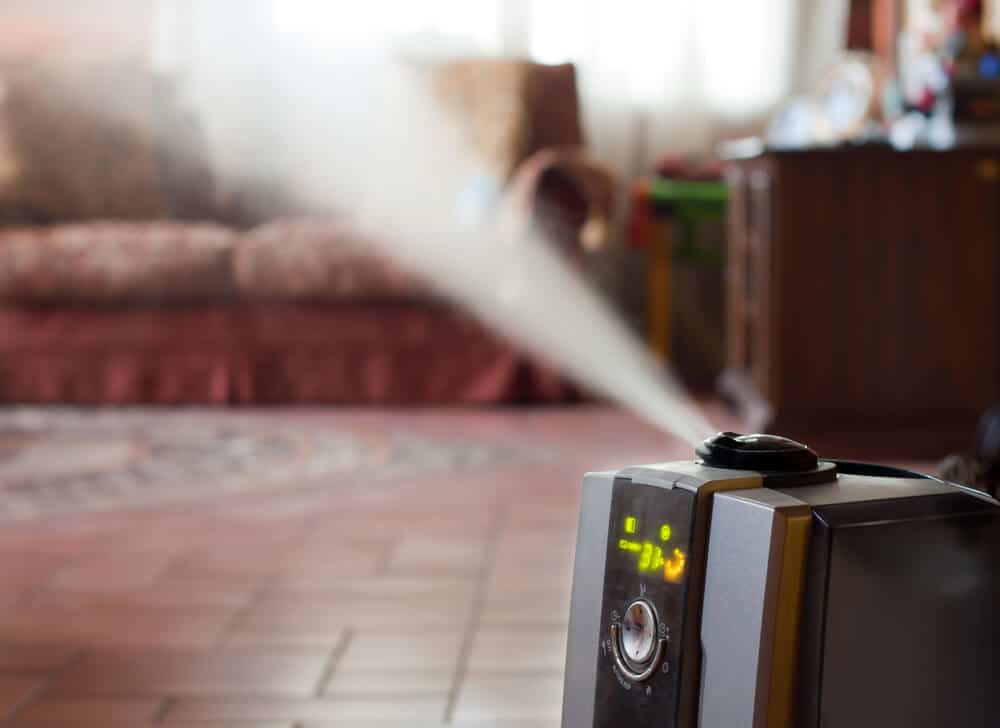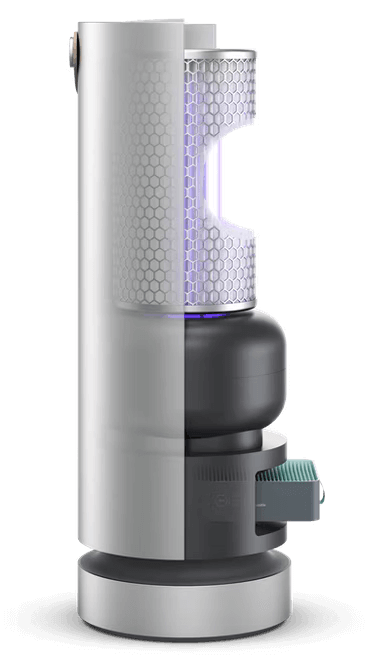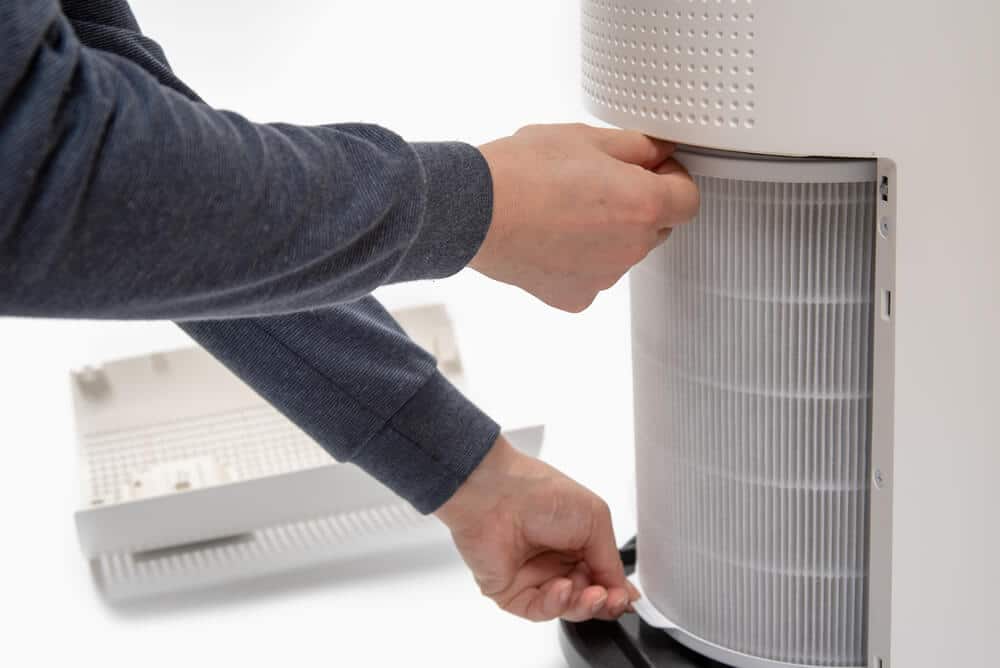If you’re having trouble sleeping it could be down to the air quality in your bedroom.
Unseen to the naked eye there are tons of microscopic pollutants drifting through the air, including dust mites, pet dander, mold spores, and even viruses.
All of these pollutants can be detrimental to our health, especially those who suffer from allergies or any respiratory problems.
The good news is there are steps you can take to improve the air you breathe inside your bedroom. One of which is investing in a good air purifier.
According to the National Association of Home Builders the average bedroom measures between 309 and 481 square feet. What this means is that you don’t need a super-powerful, nor expensive air purifier to effectively clean the air in your bedroom.
In many cases, a compact model that’s inexpensive and good at what it does can do just fine. That being said, you don’t want to sell yourself short when purchasing an air purifier. At the end of the day, it’s your health you’re improving and how can you put a price on that?
So, before you rush out and buy the first model that you come to, take a few moments to consider what it is you actually need from an air purifier.
Here are a few things to bear in mind:
- Noise level – Having an air purifier in the bedroom is great in terms of all the clean air you get to breathe as you snooze. However, some models can be pretty noisy. And, unless you’re someone who’s an extremely deep sleeper and hears nothing in their sleep, this needs to be a top consideration. Most air purifiers operate at a noise level that’s somewhere between 21 decibels and 70 decibels. The good news is that a majority of high efficiency air purifiers available do have a variety of fan speeds to choose from which will affect the noise output and so can be adjusted to a level to suit. This means you should ideally you invest in one that’s noise level can be set low enough to not disrupt your sleeping.
- Room size – You need to get the dimensions of your bedroom to ensure you buy the most efficient air purifier you can. Buying one that’s too powerful for the room you’re in, will clean the air just fine, but is a waste of money. On the flip side, buying an air purifier that’s too small for the bedroom it’s going in will have minimal effect on the improving of the air you breathe. Many of the brands that produce purifiers measure in cubic feet coverage and that is likely to be a metric you see mentioned. In this guide we focus on air purifiers specifically aimed at bedrooms but some of the devices reviewed can also be used as a portable air purifier and just as easily used in a living room as your bedroom.
- Space – Another consideration to think about is where you’re going to place the air purifier. You need to make sure it has enough room to operate properly, yet you don’t really want to place it somewhere it will become a trip hazard. Some models are wall mountable too. So, if you are lacking in floor space, one of these models might be better for you.
These are the main considerations to think about before you make your final choice. Another factor to consider is if you have pets, you may want to get one that’s aimed specifically at tackling pet dander and pet hair. Or, if you suffer from any kind of breathing problem, such as asthma, you may want to opt for the one that cleans air the fastest.
Either way, the following list contains both. Keep reading to see which model will best suit your needs.
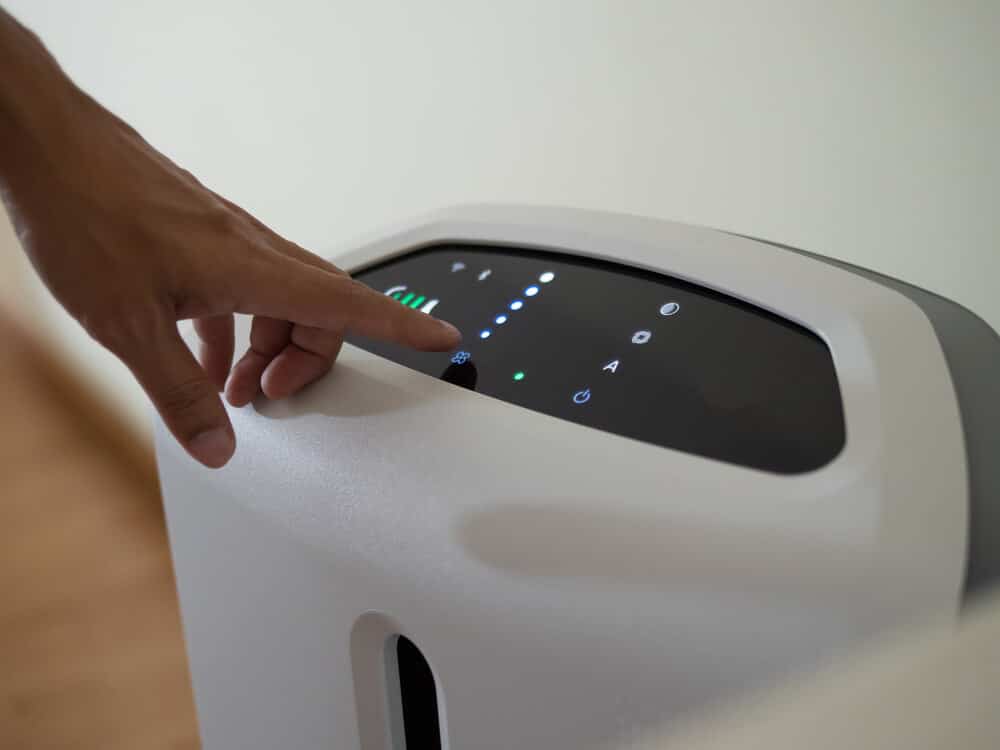
Top 10 Best Air Purifiers for Bedrooms
Medify MA-40 2.0 Medical Grade True HEPA
Best for Larger Bedrooms
If you’ve got quite a large bedroom, then you’re going to need an air purifier that’s capable of cleaning the air in a bigger space. The Medify MA-40 Medical Grade True HEPA air purifier is one such model.
Measuring in at just 10.5” x 11” x 26”, and weighing 15 pounds, you’d be surprised that such a compact machine could be so effective, but it is. This device is capable of cleaning the air in a room of up to 1600 square feet in size in just one hour. Any smaller rooms will obviously be done much faster, with a 420 square foot room taking just 15 minutes to filter the air effectively.
There are three different fan speeds to choose from, including a sleep and eco mode. While the maximum noise level on this machine is 60 decibels, which is fairly high, with the sleep mode activated this is reduced significantly.
It uses a 4-stage HEPA-type filtration system in which to effectively remove 99.97% of particles right down to 0.1 microns in size, including hair, fibers, dust, and pollen. And it’s equipped with a substantial carbon filter in which to remove smoke and toxic odors.
It also features a tempered glass control panel that’s not only easy to use, but also helps to protect your air purifier from damage. And, there’s a child lock for preventing kids or pets from changing the settings accidentally. So, it’s easy to see why this is the best large room air purifier.
Honeywell HPA300 TrueHEPA Air Purifier
Best for Asthmatics
Dealing with allergies, or respiratory conditions can be challenging at the best of times and having to sleep in a room that’s full of air pollution, is likely to exasperate the condition. Thankfully there are a few exceptional air purifiers out there that can help prevent you breathing air that’s unclean, one of which is the Honeywell HPA300 TrueHEPA Air Purifier.
Made by a top Fortune-100 brand, this machine works wonders at filtering all those nasty allergens and other airborne particles from the air. In terms of capability, it can filter a pretty large room of up to 465 square feet in size. And, it’s capable of up to 5 air changes per hour (ACH).
There are three standard fan modes to choose from with the Honeywell HPA300. There’s an Allergen mode, a General mode, and a Germ mode. Another great feature this air purifier has to offer is that it’s equipped with a Turbo Mode. With this setting, the fan is thrown into overdrive and goes into a maximum cleaning mode which is perfect for anyone suffering from any breathing difficulties or allergies. As a result the CADR rating, or clean air delivery rate of this appliance is extremely high in comparison to other brands and devices we reviewed.
Featuring only a True HEPA filtration system, there are no harmful ozone emissions given off with this product, which is another bonus for those with asthma.
hOmeLabs Air Purifier
Best for those on a Budget
While investing in a good air purifier is a great way to improve the quality of the air you breathe, and effectively the quality of your overall life, it does come at a financial cost. On top of the initial cost of the product, you also have the running costs of the device to consider. However, thanks to the hOmeLabs Air Purifier, you can keep those costs down to a minimum and still bag yourself a highly effective air purification system.
Capable of filtering a room that’s up to 200 square feet in size, this air purifier is great for cleaning the air in smaller bedrooms. It works by using a 3-layer filtration system, including an activated carbon filter in which to reduce odors. And, being equipped with a HEPA H13 filter, it’s effective at removing 99.97% of all air particles, with each filter lasting up to 2100 hours. So, you will be breathing in air cleaner, for longer.
Aside from the price factor, one of the best things to enjoy from this machine is that it’s so compact and lightweight. The actual measurements are just 7.87” x 7.87” x 12.8”, and it weighs less than 7 pounds. So, you can move it around the room as often as you see fit without so much as breaking a sweat. Perfect for all those small spaces.
Vremi Large Room Home Air Purifier
Best All-rounder
There is a great deal of choice when it comes to buying an air purifier. However, not all are any good, and hardly any of them tick all of the boxes. With that being said, the Vremi Large Room Home Air Purifier comes pretty close. It’s effective, it looks good, and it’s affordable.
Measuring in at 8.7” x 8.7” x 15.5”, this device is capable of filtering a room of up to 300 square feet in size thanks to its mighty 3-stage filtration system. It consists of a pre-filter to tackle all those larger airborne particles, a True HEPA filter in which to take care of pretty much all other airborne particles as small as 0.3 microns in size, and an activated carbon filter in which to reduce odors within the bedroom.
One of the best features of this air purifier is its innovative design. With a 360-degree aerodynamic air intake system, this purifier draws in air from every angle to make sure no part of the room is left unfiltered. It also features a 2, 4, or 8-hour timer for added convenience as well as a warm night light with multiple brightness levels to choose from.
LEVOIT LV-H133 Air Purifier
Best for Pet Owners
Whether you let your pet sleep in your bedroom or not, if you do have any furry friends living under the same roof, you can guarantee their hairs, dander, and odors will get everywhere. But, with the help of the LEVOIT LV-H133 Air Purifier in your bedroom, you can at least keep your sleeping chamber fresh, and filled with breathable, clean air.
When it comes to performance, this is one mighty efficient air purifier. In just 30 minutes it can effectively filter a room of up to 881 square feet in size. That’s some serious air cleaning capability there. Surprisingly, even though it’s so powerful, the LEVOIT LV-H133 is actually very quiet when in operation. On the lowest setting, it’s just 25 decibels, which ideal when using in the bedroom.
In terms of price, it’s what’s considered a mid-range model. But in terms of features and functions, it’s probably more top-of-the-line. This innovative air filtration system provides you with real-time air quality updates via an air quality indicator. It also features an auto mode which detects dust, pollen, and other airborne particles and adjusts the fan speed to suit. This ensures you never use more power than you have to, and continually work to ensure you breathe the best quality air at all times.
There’s also a very classy LED display and a timer in which to keep your air clean while you sleep.
Germ Guardian CDAP5500B Air Purifier
Best for Technology Lovers
Who said protecting your health had to be boring? The Germ Guardian CDAP5500B Air Purifier is one that combines the best of innovative technology with a super effective air filtration system. With Wi-Fi and Bluetooth enabled, this device is fully controllable wherever you are via the Guardian Technologies App. If you want to set the air purifier to work before you get home, you can do this via the app, and if you can’t remember if you switched it off, you can check this too. It’s even voice controllable through the likes of Alexa or Google.
It’s measures in at 8.2” x 10.5” x 29.5” and is effective at filtering small to medium-sized rooms up to 167 square feet in size. And while that may sound quite small in comparison to some of the others on this list, it’s very good at what it can do. There are 5 different fan speeds to choose from to best suit your needs, including an ultra-quiet mode which is just what you need when laying your head down to rest.
The filtration system consists of a HEPA filter and so is capable of capturing 99.97% of all allergens including pollen, dust mites, and pet dander. It also has a UV-c light that works to kill airborne viruses.
Coway Airmega 400 Smart Air Purifier
Best Top of the Range
If you’re looking for an air purifier, that not only works exceptionally well but is going to add a little class and sophistication to your bedroom, then be sure to check out the Coway Airmega 400 Smart Air Purifier. Granted, this is not a device for those with shallow pockets, but, if budget’s not an issue, and simply want the best that money can’t buy, this may well be the best air purifier for you.
This model is capable of filtering the air in a room that’s up to 1560 square feet, twice in one hour, which is nothing short of amazing. It uses a combined activated carbon and True HEPA filter to reduce 99.97% of all those harmful allergens and irritants floating around.
There are 5 fan speeds to choose from, including a sleep mode, that’s practically silent when in use. Even at the highest setting, it’s a maximum of 43.2 decibels. It also features a Smart Mode with 3 settings. With this function in place, the air purifier adjusts to its surroundings, adjusting the fan automatically based on the current air quality of the room. This ensures you get the cleanest air at all times.
Alen BreatheSmart Classic P1000 Air Purifier
Best for Filter Options
Another top of the range model to hit the list is the Alen BreatheSmart Classic P1000 Air Purifier. It may be a little on the pricey side, but what it has to offer, is worth every penny.
Effective of cleaning a room of up to 110 square feet in just 30 minutes, there aren’t many models out there as efficient as this. It uses a 3-stage air cleaning system, which in the middle, hosts a HEPA air filter. However, the difference with this air purifier is that you can select from 1 of 4 different levels of HEPA filtering. HEPA-Pure is the standard HEPA filter that’s considered the base model. HEPA-Fresh adds to the mix an activated carbon filter, keeping light odors at bay.
While HEPA-Silver steps it up even further by using a filter containing anti-microbial Silver-Ion threads, preventing the growth of bacteria and mold. HEPA-OdorCell contains a filter equipped with Molecular Conversion Powder to destroy odors at a molecular level.
Another of the machine’s most prominent qualities is the fact that it’s so quiet when in use. Even at it’s highest setting, it’s just 56 decibels, so you should have no trouble sleeping with this in operation. It also comes with a lifetime warranty. Sold yet?
BlueAir Blue Pure 411+ Air Purifier
Best for Quiet
While some people can sleep right through the heaviest of thunderstorms without so much as a murmur, others will be up at the slight drop of a raindrop falling on the window. If you’re someone who struggles to sleep with too much noise going on, but you still want to reap all the amazing benefits a good air purifier can offer then the BlueAir Blue Pure 411+ is the model for you.
Being quiet when in use is one of the best qualities an air purifier can have when using it in the bedroom, and this device has that covered to a tee. On its highest setting, this air purifier produces 46 decibels, which is the equivalent to the noise level of a library. When on its lowest setting, it reaches just 17 decibels, which is barley the equivalent of a whisper. It’s even been Quiet Mark awarded, so you know it’s going to be peaceful.
In addition to being super quiet, the BlueAir Blue Pure 411+ is also a fairly efficient machine, capable of filtering small rooms of up to 185 square feet in size. It uses a combination filter that includes an activated carbon filter in which to reduce odors and a HEPA-Silent filter which effectively removes 99.97% of airborne particles including dust, pollen, and viruses.
Dyson Pure Cool DP04
Best for Effectiveness
As with all Dyson made products, the Dyson Pure Cool DP04 is a technological marvel. It’s a top-quality air purifier that not only works to an exceptionally high standard when it comes to improving your indoor air quality but is also one of the best-looking models out there too.
With a design that fits outside the standard box or cylinder shape, this innovative air purifier uses a 360-degree filtration system in which to project purified air throughout your bedroom. Using its Air Multiplier Technology it can deliver up to 77 gallons of air per second, and thanks to its adjustable oscillation feature, you can direct the air in the exact position you want or leave it to clean the whole room – the choice is yours.
In addition to being super classy and extremely effective, the Dyson Pure Cool DP04 also has a number of other great features to offer including an automatic sensor to regulate the air for you; a clear to read LCD display that lets you know the status of the air quality at any time; a night-time mode to keep the noise level to a minimum while you sleep; and a diffused mode that projects air through the back of the device while still maintaining effective purification.
And, it works with Amazon Alexa, Siri, and the Dyson Link App for more convenient controlling.
As you can see, there are many a good model out there when it comes to air purifiers for the bedroom. It’s just a case of figuring out what it is you want most from an air purifier (i.e. as quiet as possible, or as technologically advanced as you can get), and then finding the right match for you. Hopefully, with the help of this review guide, we’ve made that process a little easier for you.


